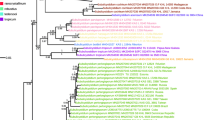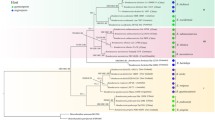Abstract
The phylogenetic relationships of Chalara and allied taxa are studied based on ribosomal DAN sequences. Partial 28S rDNA and 18S rDNA regions from 26 strains were sequenced in this study. These and related sequences from GenBank were analyzed using parsimony and Bayesian analyses. Most of the Chalara species clustered in a strongly supported monophyletic lineage representing Helotiales. However, a few Chalara species appeared closely related to Xylariales. The phylogenetic significance of morphological characters observed in Chalara species are evaluated based on our sequence analyses. Conidial septation, conidial width and conidiophore pigmentation are thought to be indicative in understanding their evolutionary relationships. Sterile setae, which traditionally have been used to delimitate Chaetochalara from Chalara, are phylogenetically insignificant.



Similar content being viewed by others
References
Berbee ML, Yoshimura A, Sugiyama J, Taylor JW (1995) Is Penicillium monophyletic? An evaluation of phylogeny in the family Trichocomaceae from 18S, 5.8S and ITS ribosomal DNA sequence data. Mycologia 87:210–222. doi:10.2307/3760907
Buschbom J, Mueller G (2004) Resolving evolutionary relationships in the lichen-forming genus Porpidia and related allies (Porpidiaceae, Ascomycota). Mol Phylogenet Evol 32:66–82. doi:10.1016/j.ympev.2003.11.012
Cai L, Jeewon R, Hyde KD (2006) Phylogenetic investigations of Sordariaceae based on multiple gene sequences and morphology. Mycol Res 110:137–150. doi:10.1016/j.mycres.2005.09.014
Campbell J, Volkmann-Kohlmeyer B, Grafenhan T, Spatafora JW, Kohlmeyer J (2005) A re-evaluation of Lulworthiales: relationships based on 18S and 28S rDNA. Mycol Res 109:556–568. doi:10.1017/S0953756205002716
Coetsee C, Wingfield MJ, Crous PW, Wingfield BD (2000) Xenochalara, a new genus of dematiaceous hyphomycetes for Chalara-like fungi with apical wall building conidial development. S Afr J Bot 66:99–103
Decock C, Delgado G, Seifert K (2005) Taxonomy and phylogeny of Synchaetomella lunatospora, a new genus and species of synnematous fungus from Southeast Asia. Antonie Van Leeuwenhoek 88:231–240. doi:10.1007/s10482–005–7210–7
Doyle JJ, Doyle JL (1987) A rapid DNA isolation procedure for small quantities of fresh leaf tissue. Phytochem Bull 19:11–15
Duong LM, McKenzie EHC, Lumyong S, Hyde KD (2008) Fungal succession on senescent leaves of Castanopsis diversifolia in Doi Suthep-Pui National Park, Thailand. Fungal Divers 30:23–36
Ellis MB (1961) Dematiaceous Hyphomycetes. II. Mycol Pap 79:1–23
Fulton CE, Brown AE (1997) Use of SSU rDNA group-I intron to distinguish Monilinia fructicola from M. laxa and M. fructigena. FEMS Microbiol Lett 157:307–312
Gams W (2000) Phialophora and some similar morphologically little-differentiated anamorphs of divergent ascomycetes. In: Seifert KA, Gams W, Crous PW, Samuels GJ (eds) Molecules, morphology and classification: towards monophyletic genera in Ascomycetes. Stud Mycol 45:187–199
Gams W, Holubová-Jechová V (1976) Chloridium and some other dematiaceous hyphomycetes growing on decaying wood. Stud Mycol 13:1–99
Gams W, Philippi S (1992) A study of Cyathicula strobilina and its Chalara anamorph in vitro. Persoonia 14:547–552
Gebhardt H, Weiss M, Oberwinkler F (2005) Dryadomyces amasae: a nutritional fungus associated with ambrosia beetles of the genus Amasa (Coleoptera: Curculionidae, Scolytinae). Mycol Res 109:687–696. doi:10.1017/S0953756205002777
Gernandt DS, Stone JK (1999) Phylogenetic analysis of nuclear ribosomal DNA places the nematode parasite, Drechmeria coniospora in Clavicipitaceae. Mycologia 91:993–1000. doi:10.2307/3761630
Gernandt DS, Platt JL, Stone JK, Spatafora JW, Holst-Jensen A, Hamelin RC, Kohn LM (2001) Phylogenetics of Helotiales and Rhytismatales based on partial small subunit nuclear ribosomal DNA sequences. Mycologia 93:915–933. doi:10.2307/3761757
Hall TA (1999) BioEdit: a user-friendly biological sequence alignment editor and analysis program for Windows 95/98/NT. Nucleic Acids Symp Ser 41:95–98
Huelsenbeck JP, Ronquist FR (2001) MRBAYES: Bayesian inference of phylogenetic trees. Biometrics 17:754–755
Issakainen J, Jalava J, Eerola E, Campbell CK (1997) Relatedness of Pseudallescheria, Scedosporium and Graphium pro parte based on SSU rDNA sequences. J Med Vet Mycol 35:389–398. doi:10.1080/02681219780001481
Jacobs A, Cortzee MPA, Wingfield BD, Jacobs K, Wingfield MJ (2003) Phylogenetic relationships among Phialocephala species and other ascomycetes. Mycologia 95:637–645. doi:10.2307/3761940
Kamgan NG, Jacobs K, de Beer ZW, Wingfield MJ, Roux J (2008) Ceratocystis and Ophiostoma species including three new taxa, associated with wounds on native South African trees. Fungal Divers 29:37–59
Kendrick B (1980) The generic concept in hyphomycetes – A reappraisal. Mycotaxon 11:339–364
Kirk PM, Spooner BM (1984) An account of the fungi of Arran, Gigha and Kintyre. Kew Bull 38:503–597. doi:10.2307/4108573
Kirk PM, Cannon PF, David WM, Stalpers JA (2008) Dictionary of the Fungi, 10th edn. CABI Publishing, Wallingford, UK
Kishino H, Hasegawa M (1989) Evaluation of the maximum likelihood estimate of the evolutionary tree topologies from DNA sequence data, and the branching order of Hominoidea. J Mol Evol 29:170–179. doi:10.1007/BF02100115
Kodsueb R, McKenzie EHC, Lumyong S, Hyde KD (2008a) Diversity of saprobic fungi on Magnoliaceae. Fungal Divers 30:37–53
Kodsueb R, McKenzie EHC, Lumyong S, Hyde KD (2008b) Fungal succession on woody litter of Magnolia liliifera (Magnoliaceae). Fungal Divers 30:55–72
McKenzie EHC, Pinnoi A, Wong MKM, Hyde KD, Jones EBG (2002) Two new hyaline Chalara species, and a key to species described since 1975. Fungal Divers 11:129–139
Müller E, Samuels GJ (1982) Anamorphs of pyrenomycetous Ascomycetes. III. The Sporoschisma and Chalara anamorphs of Melanochaeta aotearoae. Sydowia 35:155–161
Müller E, Harr J, Sulmont P (1969) Deux ascomycètes dont le stade conidien présente des conidies phaeophragmiées endogènes. Rev Mycol 33:369–378
Nag Raj TR, Kendrick B (1975) A monograph of Chalara and allied genera. Wilfrid Laurier University Press, Waterloo, Ontario, Canada
Page RDM (1996) TREEVIEW: An application to display phylogenetic trees on personal computers. Comput Appl Biosci 12:357–358
Paulin AE, Harrington TC (2000) Phylogenetic placement of anamorphic species of Chalara among Ceratocystis species and other ascomycetes. Stud Mycol 45:209–222
Paulin-Mahady AE, Harrington TC, NcNew D (2002) Phylogenetic and taxonomic evaluation of Chalara, Chalaropsis, and Thielaviopsis anamorphs associated with Ceratocystis. Mycologia 94:62–72. doi:10.2307/3761846
Pinnoi A, Lumyong S, Hyde KD, Jones EBG (2006) Biodiversity of fungi on the palm Eleiodoxa conferta in Sirindhorn peat swamp forest, Narathiwat, Thailand. Fungal Divers 22:205–218
Pinruan U, Hyde KD, Lumyong S, McKenzie EHC, Jones EBG (2007) Occurrence of fungi on tissues of the peat swamp palm Licuala longicalycata. Fungal Divers 25:157–173
Platt JL, Spatafora JW (2000) Evolutionary relationships of nonsexual lichenized fungi: molecular phylogenetic hypotheses for the genera Siphula and Thamnolia from SSU and LSU rDNA. Mycologia 92:475–487. doi:10.2307/3761506
Posada D, Crandall KA (1998) Modeltest: testing the model of DNA substitution. Bioinformatics 49:817–818. doi:10.1093/bioinformatics/14.9.817
Rannala B, Yang Z (1996) Probability distribution of molecular evolutionary trees: a new method of phylogenetic inference. J Mol Evol 43:304–311. doi:10.1007/BF02338839
Réblová M (1999) Teleomorph-anamorph connections in Ascomycetes 2. Ascochalara gabretae gen. et sp. nov. and its Chalara-like anamorph. Sydowia 51:210–222
Réblová M, Seifert KA (2004) Cryptadelphia (Trichosphaeriales), a new genus for holomorphs with Brachysporium anamorphs and clarification of the taxonomic status of Wallrothiella. Mycologia 96:343–367. doi:10.2307/3762067
Samuels GJ, Rogers JD (1990) Some ascomycetes (Fungi) occurring on tropical ferns. Brittonia 42:105–115. doi:10.2307/2807623
Seifert KA, Wingfield MJ, Kendrick B (1993) A nomenclator for described species of Ceratocystis, Ophiostoma, Ceratocystiopsis, Ceratostomella and Sphaeronaemella. In: Wingfield MJ, Seifert KA, Webber JF (eds) Ceratocystis and Ophiostoma: their taxonomy, ecology and pathogenicity. APS Press, St. Paul, Mn, pp 253–271
Shenoy BD, Jeewon R, Wu WP, Bhat DJ, Hyde KD (2006) Ribosomal and RPB2 DNA sequence analyses suggest that Sporidesmium and morphologically similar genera are polyphyletic. Mycol Res 110:916–928. doi:10.1016/j.mycres.2006.06.004
Shenoy BD, Jeewon R, Hyde KD (2007) Impact of DNA sequence-data on the taxonomy of anamorphic fungi. Fungal Divers 26:1–54
Smith GJD, Liew ECY, Hyde KD (2003) The Xylariales: a monophyletic order containing 7 families. Fungal Divers 13:175–208
Spatafora JW, Blackwell M (1994) The polyphyletic origins of ophiostomatoid fungi. Mycol Res 98:1–9
Sutton BC, Pirozynski KA (1965) Notes on microfungi. II. Trans Br Mycol Soc 48:349–366
Swofford DL (2002) PAUP*: phylogenetic analysis using parsimony (*and other methods). Version 4b10. Sinauer Associates, Sunderland, Massachusetts, USA
Thomson JD, Gibson TJ, Plewniak F, Jeanmougin F, Higgins DG (1997) The Clustal_X windows interface: Flexible strategies for multiple sequence alignment aided by quality analysis tools. Nucleic Acids Res 25:4876–4882. doi:10.1093/nar/25.24.4876
Tsui CKM, Berbee ML, Jeewon R, Hyde KD (2006) Molecular phylogeny of Dictyosporium and allied genera inferred from ribosomal DNA. Fungal Divers 21:157–166
Vilgalys R, Hester M (1990) Rapid genetic identification and mapping of enzymatically amplified ribosomal DNA from several Cryptococcus species. J Bacteriol 172:4238–4246
Wang Z, Binder M, Hibbett DS (2005) Life history and systematics of the aquatic discomycete Mitrula (Helotiales, Ascomycota) based on cultural, morphological, and molecular studies. Am J Bot 92:1565–1574. doi:10.3732/ajb.92.9.1565
Weber E, Görke C, Begerow D (2002) The Lecythophora-Coniochaeta complex II. Molecular studies based on sequences of the large subunit of ribosomal DNA. Nova Hedwigia 74:187–200. doi:10.1127/0029–5035/2002/0074–0187
Webster J, Weber R (2007) Introduction to fungi, 3rd edn. University Press, Cambridge, UK
White TJ, Bruns T, Lee S, Taylor J (1990) Amplification and direct sequencing of fungal ribosomal RNA genes for phylogenetics. In: Innis MA, Gelfand DH, Sninsky JJ, White TJ (eds) PCR protocols: a guide to methods and applications. Academic Press, San Diego, pp 315–322
Winka K, Eriksson OE (2000) Papulosa amerospora accommodated in a new family (Papulosaceae, Sordariomycetes, Ascomycota) inferred from morphological and molecular data. Mycoscience 41:97–103. doi:10.1007/BF02464316
Wu WP (2004) Chalara and allied genera from China: new species and new records of Chalara from China. Mycosystema 23:313–323
Yu ZH, Zhuang WY (2003) Phylogenetic relationships of Lachnum and related genera inferred from partial sequences of 18S rDNA. Mycosystema 22:37–45
Zhaxybayeva O, Gogarten JP (2002) Bootstrap, Bayesian probability and maximum likelihood mapping: exploring new tools for comparative genome analyses. Genomics 3:1–15
Acknowledgements
This study was financially supported by Hong Kong Research Grants Council (HKU7320/02M). The University of Hong Kong is acknowledged for providing LC with a postgraduate scholarship. We are grateful to Helen Leung and Heidi Kong (HKU), and Zhang Yan (Novozymes China) for their technical assistance. Dr. R. Jeewon and Dr. Eric McKenzie are thanked for giving valuable suggestions and pre-submission review.
Author information
Authors and Affiliations
Corresponding author
Rights and permissions
About this article
Cite this article
Cai, L., Wu, WP. & Hyde, K.D. Phylogenetic relationships of Chalara and allied species inferred from ribosomal DNA sequences. Mycol Progress 8, 133–143 (2009). https://doi.org/10.1007/s11557-009-0585-5
Received:
Revised:
Accepted:
Published:
Issue Date:
DOI: https://doi.org/10.1007/s11557-009-0585-5




